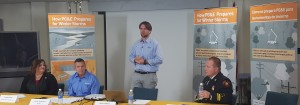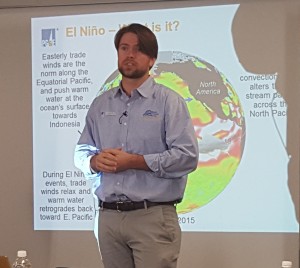
Regional Communications Director of American Red Cross Cynthia Shaw, PG&E Vice President of Emergency Preparedness and Operation Barry Anderson, G&E Meteorologist Kevin Clifford and Alameda County Fire Department division chief Jim Call brief reporters on possible impact of El Niño and the need for residents to prepare for emergencies. PHOTOS BY JUN NUCUM
SAN FRANCISCO–As 150 world leaders gathered in Le Bourget, Paris for The United Nations Conference on Climate Change, with California state, business and environmental leaders led by Governor Jerry Brown trooping to the same place to voice their commitment to fighting greenhouse gases, experts at home advised Californians to prepare for the effects of the comingEl Niño weather phenomenon.
Kevin Clifford, senior meteorologist at Pacific Gas and Electric (PG&E) at recent press event told Californians to brace themselves for a change in the jet stream across the northern Pacific as it moves towards California, particularly the San Francisco Bay Area and even southern California.
“In the past 65 years, there were about three events that were ranked very strong El Niño. 1972-73, 1983-84, and 1997-98,” explained Clifford. “Stormy weather is expected for California.”
A strong El Niño condition, Clifford explained, breaks the jet stream into two, one of which brings more storm activity to California. El Niño is more of a pattern than an individual event “so we will see strong consistent activity more week in week out wet-hot condition.”
This coming El Niño, while expected to be slightly weaker than the 1997-98 major El Niño, will be stronger than the 1972-73 event.
Consistent storm activity
Clifford said no one really knows when El Niño will show up other than it is expected to develop during this winter season, when a pattern of consistent storm activity can be seen.
But if it is anything like 1997-98 the most prevalent effects of El Niño would be felt in January to February and even March. “The biggest impact of El Niño will be mid- and late winter with highest number of precipitation,” Clifford emphasized.
Barry Anderson, PG&E vice president of Emergency Preparedness and Operation, said coming El Niño could cause widespread flooding and power outages affecting more than a million customers.
Anderson said his unit’s mission is to “respond quickly, safely, and to bring back our community and customers back power as quickly as possible after an event.”
Preparing for impact
He said PG&E has been preparing for storms by using advanced meteorology tools to forecast where storm impacts will be most significant and adding innovative technology to its electrical grid.
Among others, the important additions in PG&E resources for El Niño events include:
- The SmartMeter data that PG&E receives within seconds of an outage to help system operators quickly determine the scope and level of response needed.
- Through the Smart Grid, advanced automated technology on power lines has been installed throughout PG&E’s service area that can automatically “self-heal” the grid by re-routing the flow of electricity around a damaged power line and effectively restoring power to the majority of impacted customers within minutes.
- PG&E’s has been preparing in advance to prevent the potential impact of flooding, erosion and landslides on gas lines.
Emergency plan
Alameda County Fire Department division chief Jim Call underscored the need for residents to have an emergency plan, an emergency kit ready with needed supplies “so you can be self-reliant for 72 hours.”
The fire department is working with other fire departments, the police departments, PG&E, and public works, “to develop our plans in the event of flooding, power outages and windstorms.”
Call appealed to residents to check the heavy trees around their residence and get them trimmed before the storms start.
Regional Communications Director of American Red Cross Cynthia Shaw said they working with partner agencies and emergency responders to plan for shelters, food and safe places for people to go should they be affected by flooding or landslides.
“What we ask the community to do is, first, to make a kit composed of food, water, medication, battery-powered radios, flash lights, cell phone chargers, diapers for children, needs for pets, food and so forth. Have those things in easy to carry large container that you can take to evacuate,” Shaw exhorted.
She also advised families to plan where to meet should they be separated by natural calamities and to know where the planned shelters are so they could seek refuge if necessary.
Like us on Facebook


